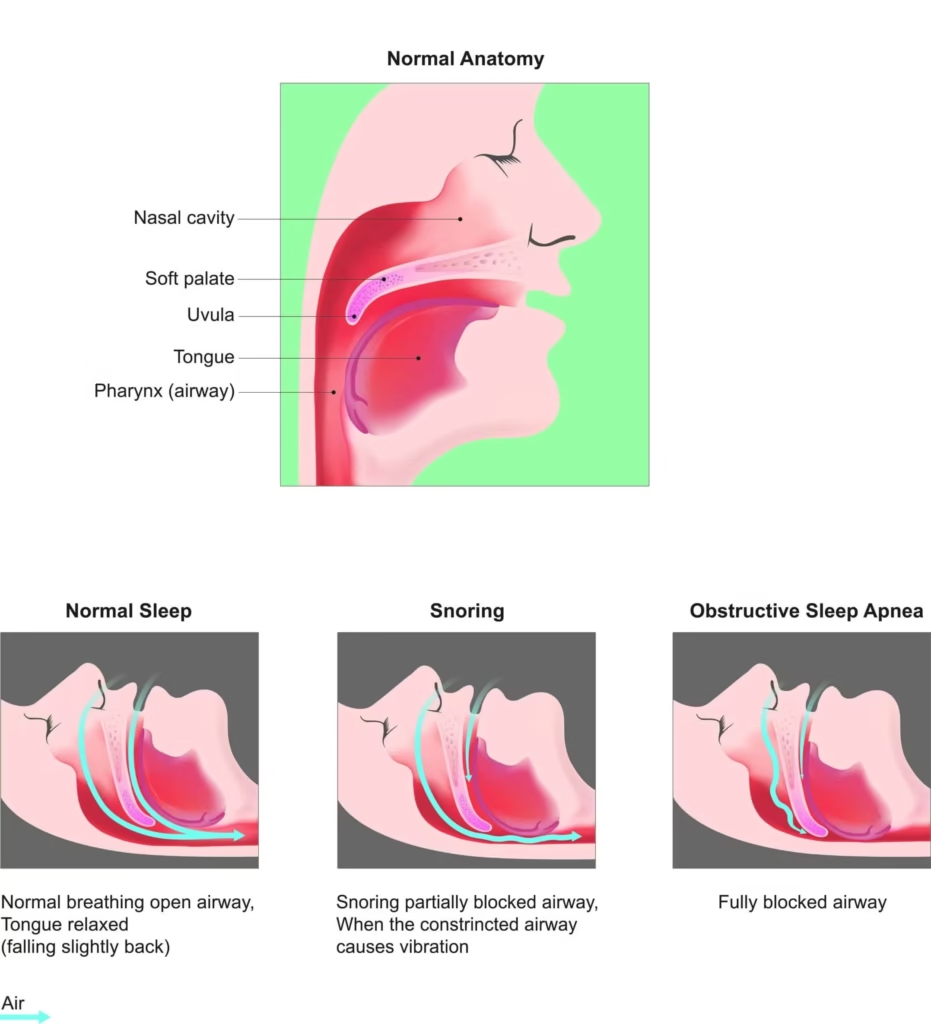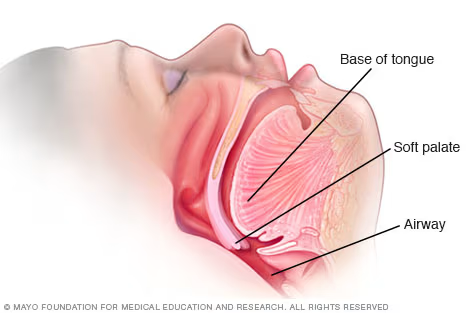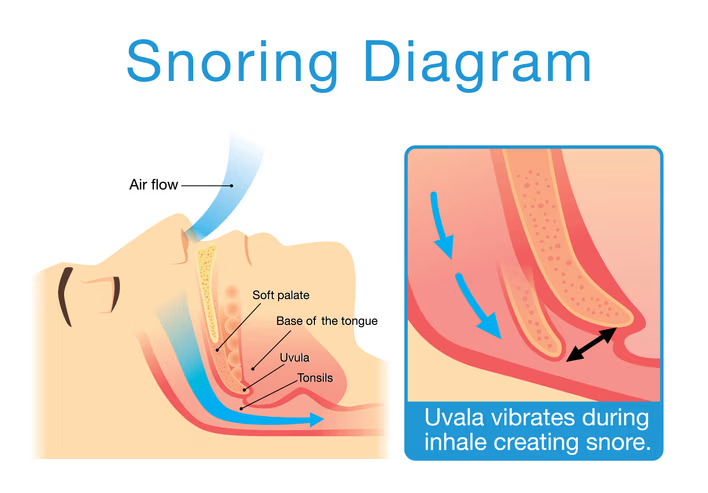Understanding Snoring and Sleep Apnea

Snoring is a common condition affecting approximately 24% of Singapore’s population who are considered loud habitual snorers.
While many people snore occasionally, persistent and loud snoring can be more than just a nuisance for bed partners – it may indicate a potentially serious underlying condition called Obstructive Sleep Apnea (OSA).
Snoring occurs due to the vibration of tissues lining the upper air passages during sleep. In most cases, it results from multiple factors working together.
When you sleep, the muscles in your throat relax, causing the walls of your upper airway to fall together and narrow.
Read more: Health Screening in Singapore
This narrowing creates vibrations as air passes through, producing the characteristic snoring sound.
Obstructive Sleep Apnea (OSA) is a sleep-related breathing disorder where the upper airway becomes partially or completely blocked during sleep.
This blockage causes breathing interruptions, leading to drops in oxygen levels in the body.
These interruptions force the individual to briefly awaken multiple times throughout the night, resulting in fragmented sleep and excessive daytime sleepiness.
A recent Singapore Health Study estimated that approximately 30.5% of Singapore’s population has moderate to severe OSA.
With rising obesity rates, which is a significant risk factor, this prevalence is expected to increase further.
This will help: Which ENT Doctor in Singapore Should You Consider?
Causes and Risk Factors

Several factors can contribute to snoring and OSA:
Anatomical Factors
Several anatomical factors can contribute to snoring and obstructive sleep apnea by narrowing or obstructing the airway during sleep.
A deviated nasal septum, which is the cartilage partition between the two sides of the nose, can significantly restrict airflow and contribute to breathing difficulties.
Enlarged turbinates, adenoids, and tonsils can also create physical obstructions in the upper airway.
Structural features of the mouth and throat play important roles as well.
A long soft palate and uvula can partially block the airway, while a bulky tongue can obstruct breathing during sleep when muscle tone decreases.
Nasal polyps create additional blockages in the nasal passages, and various facial and jaw abnormalities can alter the anatomy in ways that predispose individuals to airway obstruction.
This might help: Orthognathic (Jaw) Surgery in Singapore: Costs, Risks, Recovery
Lifestyle Factors
Several lifestyle choices significantly impact the likelihood and severity of snoring and sleep apnea.
Obesity is a major contributing factor, as excessive fat accumulation in the upper airway can amplify existing anatomic narrowing and create additional pressure on breathing passages.
Alcohol consumption causes relaxation of muscles and swelling of airway tissues, making obstruction more likely during sleep.
Smoking leads to chronic inflammation and swelling of the airway tissues, which compounds other risk factors.
The use of sedatives and sleeping pills can cause the upper airway muscles to relax excessively, reducing the body’s natural ability to maintain an open airway during sleep.
This might help: Alcohol Addiction Treatment in Singapore
Other Factors
Several additional factors can contribute to snoring and sleep apnea development.
Aging brings an associated loss of general muscle tone, including the muscles that help keep the airway open during sleep.
Gender plays a role, with males being statistically more likely to snore than females.
Medical conditions can also contribute to these issues. Acid reflux causes congestion of the throat due to the reflux of stomach acid, while nasal congestion resulting from allergies or other conditions can force mouth breathing and increase the likelihood of airway obstruction.
Related article: Acid Reflux and GERD in Singapore: Causes, Symptoms, and Treatments
Health Implications of Untreated Snoring and OSA
Untreated obstructive sleep apnea can lead to serious health complications that affect multiple body systems.
Cognitive effects include memory problems and difficulty concentrating, while cardiovascular risks are particularly concerning.
The risk of stroke increases dramatically, with almost 70% of stroke patients having OSA, and high blood pressure affects over 35% of people with sleep apnea.
Metabolic consequences include an increased risk of developing type 2 diabetes, while mental health impacts can manifest as depression and mood disorders.
Cardiovascular complications are severe, with the risk of heart failure and heart attack increased by two to three times compared to those without sleep apnea.
Safety concerns are significant, as untreated sleep apnea increases the risk of motor vehicle accidents by seven times and also elevates the risk of work-related accidents.
Additional complications include problems with surgery and medications, liver problems, and in children, issues with growth and cognitive development that can have lasting impacts.
Read more: Type 2 Diabetes Treatment in Singapore: Symptoms, Risks
Recognizing the Signs of Sleep Apnea
While not all snorers have sleep apnea, it’s important to recognize warning signs that may indicate the presence of OSA.
Loud, persistent, and disruptive snoring that disturbs others is often the most noticeable symptom.
Witnessed pauses in breathing during sleep, typically observed by bed partners, are particularly concerning indicators.
Daytime symptoms include excessive sleepiness despite adequate sleep duration, morning headaches upon waking, and poor concentration accompanied by irritability.
Sleep-related symptoms encompass frequent awakening at night, night sweats, and mouth breathing during sleep.
More alarming signs include waking up with gasping or choking sensations that indicate significant breathing disruption.
Additional symptoms can include various sleep disturbances such as sleepwalking and sleep talking.
In children, the presentation may be different, with difficulty focusing, hyperactivity, and impulsiveness being more prominent.
Mood swings and difficulty controlling emotions can affect both adults and children with untreated sleep apnea, significantly impacting quality of life and relationships.
Diagnosis Process
If you suspect you have a snoring problem or OSA, consult your physician who may refer you to a Sleep Disorders Centre for thorough evaluation. The diagnostic process typically includes:
- A comprehensive sleep history review
- Physical examination, including an endoscopic upper airway evaluation
- Sleep study, which can be conducted in two ways:
- An inpatient overnight diagnostic polysomnography (PSG) test in a sleep laboratory
- A portable home sleep test (HST)
The sleep study monitors your breathing patterns, oxygen levels, heart rate, and other vital signs during sleep to determine if you have OSA and its severity.
Treatment Options
Treatment for snoring and OSA requires a multidisciplinary approach, including both medical and surgical options. The therapeutic choice is individualized based on the underlying causes and severity of the condition.
Conservative Treatment Options
Lifestyle Modifications
- Weight loss if you are obese
- Avoiding alcohol, especially after 6pm
- Avoiding sleeping pills and sedatives
- Quitting smoking
- Adopting regular exercise routines and fixed sleep patterns
- Sleeping on your side instead of your back
- Treating nasal congestion with appropriate medications
Read more: The Ultimate Guide to Losing Weight in Singapore
Devices and Appliances
- Nasal CPAP (Continuous Positive Airway Pressure): Delivers pressurized air into the upper airway via a nasal mask, keeping the airway open during sleep. This is typically prescribed for OSA rather than simple snoring.
- Dental Appliances: Custom-made devices that hold the jaw in a forward position during sleep to maintain an open airway.
- Nasal Strips: These increase the area of nasal passage to enhance breathing. However, they are ineffective against sleep apnea.
Surgical Treatment Options
If conservative treatments are ineffective, various surgical procedures may be considered:
Nasal Surgery
- Straightening the nasal septum (septoplasty)
- Turbinectomy (reducing enlarged turbinates)
- Nasal valve reconstruction
- Removal of nasal polyps
Palatal Surgery
For abnormal structures at the palate level, options include:
- Traditional Uvulopalatopharyngoplasty (UPPP)
- Modified techniques like uvulopalatal flap, extended uvulopalatal flap, and lateral pharyngoplasty
- Success rates range from 50-60% in carefully selected patients, but may be lower (5-30%) in unselected patients
Hypopharyngeal and Base of Tongue Surgery
For obstruction at the tongue base level, procedures include:
- Median glossectomy (removing midportion of the tongue)
- Lingualplasty
- Volumetric reduction by radiofrequency
- Skeletal advancement techniques (inferior sagittal mandibular osteotomy and genioglossus advancement)
- Hyoid procedures
Maxillomandibular Advancement Surgery
This more aggressive procedure involves the forward movement of the lower jaw and midface, creating more room for the tongue and opening the airway. It’s typically considered when more conservative surgeries have failed.
Tracheostomy
This procedure creates a hole in the trachea, bypassing the upper airway obstruction completely. While it has a 100% success rate, it’s rarely used due to patient acceptance issues and the availability of other treatment options.
Radiofrequency Thermal Ablation
Also known as somnoplasty, this procedure uses radiofrequency energy to stiffen and shrink the tissues of the soft palate and tongue base.
Natural Ways to Reduce Snoring
Here are some natural approaches that may help reduce snoring:
- Sleep position: Avoid sleeping on your back as this can cause your tongue and soft tissues to drop and obstruct your airway. Try sleeping on your side instead.
- Elevate your head: Raising the head of your bed by a few inches may help reduce snoring by keeping airways open.
- Stay hydrated: Proper hydration helps keep nasal secretions thin, reducing congestion and snoring.
- Maintain clean bedding: Regular washing of pillows and bedding can reduce allergens that may contribute to nasal congestion.
- Use a humidifier: Adding moisture to the air can help reduce nasal congestion and snoring.
- Treat nasal congestion: Using saline sprays or rinses can help clear nasal passages before bedtime.
- Be considerate to your partner:
- Allow your partner to fall asleep before you go to bed
- Provide earplugs for your partner
- To properly insert an earplug:
- Roll the earplug into a narrow cylinder
- With the opposite hand, gently pull up the ear to straighten the ear canal
- Insert the earplug almost completely in and hold in place for at least 30 seconds to allow expansion
Management Approach in Singapore
The management of snoring and OSA in Singapore involves a multidisciplinary approach, often requiring collaboration between specialists from various fields including:
- Otolaryngology (ENT)
- Respiratory medicine
- Dental specialties (oral and maxillofacial surgery and orthodontics)
Treatment recommendations are typically based on the underlying cause of your condition.
For proper diagnosis and treatment, it’s advisable to consult an ENT specialist or Respiratory physician who can evaluate your symptoms, conduct a physical examination, and potentially arrange a sleep study.
When to See a Doctor
Consult a healthcare professional if:
- Your snoring is loud, persistent, and disruptive
- You or your bed partner notices pauses in your breathing during sleep
- You experience excessive daytime sleepiness despite getting adequate sleep
- You have morning headaches, poor concentration, or irritability
- You have a medical history of high blood pressure, heart problems, or obesity
- Your snoring is disrupting your partner’s sleep
Early diagnosis and treatment of OSA can alleviate symptoms and potentially prevent future complications.
FAQ
What causes snoring?

Snoring is caused by the vibration of tissues lining the upper air passages during sleep.
When you sleep, muscles in your throat relax, causing the walls of your upper airway to narrow and vibrate as air passes through.
Common causes include nasal congestion, a deviated septum, enlarged tonsils and adenoids, excessive weight, alcohol consumption, sleeping position, smoking, aging, and certain medications.
Most snorers experience multiple factors contributing to their condition.
How common is sleep apnea in Singapore?
According to recent studies, approximately 30.5% of Singapore’s population has moderate to severe obstructive sleep apnea (OSA).
With the rising obesity rates in Singapore, this prevalence is expected to increase further as obesity is a significant risk factor for developing OSA.
About 24% of the local population are considered loud habitual snorers, though not all snorers have sleep apnea.
How can I differentiate between simple snoring and obstructive sleep apnea?
While snoring is a common symptom of obstructive sleep apnea (OSA), not all snorers have the condition.
Signs that may indicate OSA rather than simple snoring include: pauses in breathing during sleep witnessed by others, waking up gasping or choking, excessive daytime sleepiness despite adequate sleep, morning headaches, difficulty concentrating, irritability, and frequent nighttime awakenings.
If you experience these symptoms alongside snoring, it’s advisable to consult a healthcare professional for proper evaluation.
What are the health risks associated with untreated sleep apnea?
Untreated obstructive sleep apnea can lead to serious health complications including increased risk of stroke (almost 70% of stroke patients have OSA), high blood pressure (over 35% of people with sleep apnea suffer from hypertension), type 2 diabetes, depression, heart failure and heart attack (risk increased by 2-3 times), memory problems, and a significantly higher risk of motor vehicle and work-related accidents.
The condition also affects quality of life through excessive daytime sleepiness, poor concentration, and mood disturbances.
What treatment options are available for snoring in Singapore?
Treatment options for snoring in Singapore range from conservative approaches to surgical interventions depending on the underlying cause.
Conservative treatments include lifestyle changes (weight loss, avoiding alcohol and sedatives, quitting smoking, changing sleep position), nasal strips, nasal decongestants, and dental appliances.
For more severe cases or when conservative methods fail, surgical options may include nasal surgery, palatal surgery, tongue base procedures, maxillomandibular advancement, or radiofrequency thermal ablation.
For those with OSA, CPAP (Continuous Positive Airway Pressure) therapy is often recommended.
Can snoring be cured permanently?
Whether snoring can be cured permanently depends on the underlying cause.
By addressing specific issues such as weight loss, treating nasal congestion, or correcting anatomical abnormalities through surgery, some patients may find complete relief from snoring.
However, in many cases, a combination of ongoing treatments and lifestyle modifications may be necessary to manage the condition long-term.
The effectiveness of treatment varies based on individual factors and the root cause of the snoring problem.
How do I prepare for a sleep study?
To prepare for a sleep study, maintain your regular sleep schedule for several days before the test.
Avoid caffeine and alcohol on the day of the study as these can affect your sleep patterns. Bring comfortable sleepwear, any medications you regularly take, and personal items that help you sleep.
If you’re conducting a home sleep test, follow the device setup instructions carefully. For an in-lab study, expect sensors to be attached to monitor your breathing, heart rate, oxygen levels, and body movements during sleep.
The procedure is painless and designed to collect data about your sleep patterns.
Are there any natural remedies that can help reduce snoring?
Several natural approaches may help reduce snoring including sleeping on your side instead of your back, elevating your head with an extra pillow, maintaining a healthy weight, staying well-hydrated, using a humidifier in your bedroom, treating nasal congestion with saline sprays or steam inhalation, avoiding alcohol and sedatives before bedtime, quitting smoking, and establishing regular sleep patterns.
While these methods may help with mild snoring, they might not be sufficient for more severe cases or for those with obstructive sleep apnea, which requires medical treatment.
How much does snoring treatment cost in Singapore?
The cost of snoring treatment in Singapore varies widely depending on the type of treatment required.
Conservative treatments like nasal strips or decongestants may cost just a few dollars, while custom dental appliances can range from several hundred to over a thousand dollars.
CPAP machines typically cost between $1,000 to $3,000, depending on the model and features.
Surgical interventions can range from $3,000 to $20,000 or more, depending on the complexity of the procedure. It’s advisable to check with your healthcare provider about potential insurance coverage and subsidies that may be available.
Can children suffer from snoring and sleep apnea?
Yes, children can suffer from snoring and sleep apnea. In children, the most common cause is enlarged tonsils and adenoids.
Signs of sleep apnea in children include loud snoring, mouth breathing, restless sleep, bedwetting, behavioral problems, hyperactivity, poor attention span, and learning difficulties.
If your child exhibits these symptoms, it’s important to consult a pediatric ENT specialist for evaluation.
Early diagnosis and treatment are essential to prevent complications related to growth, cardiovascular health, and neurocognitive development.

